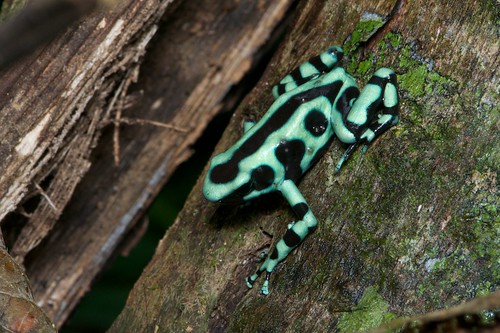 |
| You can't see me! This caterpillar blends in with mosses and lichens on a tree trunk. |
|
The advantage to blending in is obvious; cryptic animals (like the caterpillar above) are less likely to be found by predators. Selection for crypsis is so strong that many animals
alter their behavior to enhance their camouflage. Other animals, however, sport bold colors as a clear message to would-be enemies: Stay away!
 |
| Tetrio Sphinx Moth, Pseudosphinx tetrio |
These aposematic patterns are common in caterpillars that are toxic to predators. The Sphinx moth above is harmless on the outside, but inside it contains chemicals that it has accumulated from its host plants in the Dogbane family (plants with -bane in their names are often poisonous). The same concept applies to other bad tasting, dangerous, or poisonous creatures like this poison dart frog:
 |
| Oophaga pumilo warns that it is poisonous. It accumulates toxins from tiny invertebrates that it eats. |
So why don't these toxic animals double-up on defense and use camouflage too?
Without a warning signal, a bird would have to peck a to determine that it tastes bad. The prey might not be eaten, but still die from its wounds. Bright colors may also help predators learn quickly and remember their bad experiences with prey. Predators are also more cautious when pursuing bright colored prey, affording extra opportunities for escape.
There are also costs associated with being camouflaged. Crypsis only works when an animal stays on the correct backdrop, and usually only when it is staying still.
 |
| I'm a leaf. |
This frog was so well suited to the fallen leaves that it was only spotted because it moved. I looked away momentarily, and was unable to find the frog a second time.




































